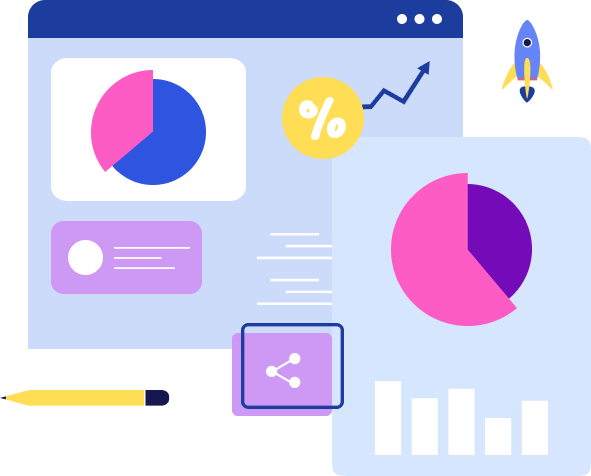
Digital marketing is a powerful tool for driving business growth. However, understanding whether your marketing efforts are delivering the desired results is crucial. Measuring the success of your digital marketing campaigns enables you to identify what works, optimize your strategies, and achieve better outcomes. In this blog, we will explore the key metrics to track, the tools you can use for accurate measurement, and some case studies that demonstrate how effective measurement can lead to improved campaign performance.
- Key Metrics
2.1. Return on Investment (ROI)
ROI or ROAS (return on ad spend) is one of the most critical metrics in digital marketing. It measures the profitability of your campaigns by comparing the revenue generated to the amount spent on the campaign. A positive ROI indicates that your campaign is effective and generating more revenue than it costs, while a negative ROI suggests that adjustments are needed.
At Globouts, we help businesses maximize their ROI by offering tailored digital marketing strategies that align with their goals.
2.2. Conversion Rate
The conversion rate is another essential metric that reflects the percentage of visitors who take a desired action, such as making a purchase, signing up for a newsletter, or filling out a contact form. A high conversion rate indicates that your campaign is effectively engaging your audience and driving them to act.
2.3. Customer Acquisition Cost (CAC)
CAC measures the cost of acquiring a new customer through your digital marketing efforts. This metric helps you understand how much you need to invest to gain a new customer and can be used to evaluate the cost-effectiveness of different marketing channels.
Globouts offers cost-effective digital marketing solutions that help businesses reduce their CAC while achieving significant growth.
2.4. Click-Through Rate (CTR)
CTR measures the percentage of people who click on your ads or links out of the total number of people who see them. A high CTR indicates that your content is relevant and compelling to your audience. This metric is particularly important in pay-per-click (PPC) campaigns, where each click represents a potential lead.
2.5. Bounce Rate
Bounce rate refers to the percentage of visitors who leave your website after viewing only one page. A high bounce rate can indicate that your landing pages or content are not engaging or relevant to your audience. Reducing bounce rates can lead to higher engagement and better conversion rates. Although not available in GA4 since May 2024, it can still be checked manually.
- Tools for Measurement
3.1. Google Analytics
Google Analytics is a powerful tool for tracking and analyzing website traffic. It provides insights into user behavior, conversion rates, bounce rates, and more. By setting up goals and tracking events, you can measure the success of your digital marketing campaigns and make data-driven decisions.
At Globouts, we offer expert Google Analytics setup and analysis services to help you get the most out of your data.
3.2. HubSpot
HubSpot is an all-in-one marketing, sales, and service platform that includes robust analytics tools. It allows you to track the performance of your campaigns, measure ROI, and analyze customer interactions across various channels. HubSpot’s reporting features make it easy to measure the effectiveness of your digital marketing efforts.
3.3. SEMrush
SEMrush is a comprehensive digital marketing tool that provides insights into SEO, PPC, content marketing, and social media. It offers detailed reports on keyword rankings, backlinks, and traffic, helping you measure the impact of your campaigns and optimize them for better results.
3.4. Social Media Analytics Tools
Social media platforms like Facebook, Twitter, and LinkedIn offer built-in analytics tools that provide insights into the performance of your social media campaigns. These tools allow you to track engagement, reach, and conversions, helping you understand how your content resonates with your audience.
Globouts specializes in social media marketing and can help you leverage these tools to improve your campaign performance.
- Case Studies
4.1. E-commerce Business
An e-commerce business partnered with Globouts to improve its digital marketing efforts. By focusing on key metrics such as ROI, conversion rate, and CAC, we were able to optimize their campaigns and achieve a 40% increase in sales. Using tools like Google Analytics and SEMrush, we identified high-performing keywords and targeted them more effectively, resulting in a higher CTR and lower bounce rates.
4.2. B2B Company
A B2B company wanted to enhance its lead generation efforts through digital marketing. Globouts implemented a comprehensive strategy that included content marketing, SEO, and PPC campaigns. By closely monitoring metrics like CTR and conversion rates, we refined their campaigns to attract more qualified leads. The result was a 30% increase in lead conversions and a 25% reduction in CAC.
4.3. SaaS Provider
A SaaS provider sought to reduce its customer acquisition costs while increasing its customer base. By utilizing HubSpot’s analytics and automation tools, Globouts developed targeted campaigns that resonated with the provider’s audience. We achieved a significant reduction in CAC and a 50% increase in customer retention rates by continuously measuring and optimizing campaign performance.
- Conclusion
Measuring the success of your digital marketing campaigns is crucial for optimizing performance and achieving business growth. By focusing on key metrics like ROI, conversion rate, and CAC, and utilizing tools like Google Analytics and SEMrush, you can gain valuable insights into the effectiveness of your efforts. Partnering with a trusted provider like Globouts.com ensures that your digital marketing strategies are data-driven, cost-effective, and aligned with your business objectives.




